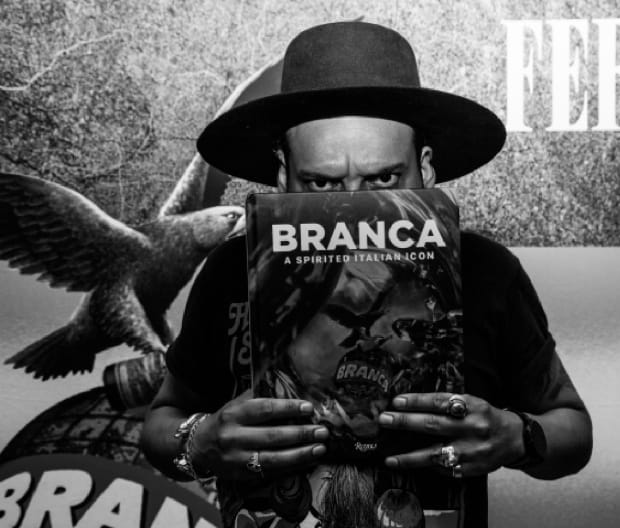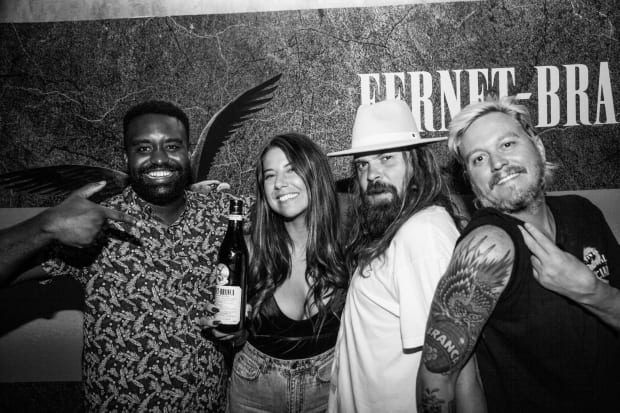Fernet is a bitter liqueur that's become a go-to for imbibers tired of fancy cocktails. Here's why.
Little Tokyo, Los Angeles—dusk. A line forms at the door of a second-floor bar located atop an anime shop. A tattoo-covered procession stretches through the courtyard, past the Korean-style soft serve joint with the fish-shaped waffle cones, past the Japanese whisky bar. This isn’t the waxed mustache and suspenders crowd the craft cocktail scene has became known for over the last decade. These folks look dressed for a Misfits concert. Of course, they’re here for a Fernet-Branca event.
During the evening, flash tattoos are inked on skin, coins bestowed on the initiated, and shots of the Italian herbal alcohol pour freely. The line begins to move. It takes an hour to get inside. Of course it takes an hour to get inside. Did we mention this is a Fernet-Branca event?

Genevive Adams, Los Angeles
What Is Fernet?
Fernet is a style of bitters or amaro (“bitter” in Italian). Like Kleenex for tissue or Q-tips for cotton swabs, most people know it as Fernet-Branca, fernet's original brand, dating back to mid-19th century Milan, Italy. Produced by the city's Fratelli Branca Distilleries—and, more specifically, "on Via Broletto, near the Church of San Tomaso,” the bottle notes—Fernet-Branca has as varied a history as any long-lived alcoholic concoction once touted for its health benefits.
“Fernet was originally marketed as an anti-choleric,” says Erin Campbell, regional portfolio manager of Fratelli Branca Distillerie (the brand's parent company). “During the 19th-century cholera outbreak, this herbaceous and medicinal potion was used in hospitals to activate a patient’s digestive system,” she says.
Related: 10 Unique Spirits and Liqueurs for Cocktails
Where Is Fernet Imbibed?
While fernet is enjoyed around the world, 75 percent of consumption traces back to Argentina. Home to the largest conglomerate of Italians outside of Italy, Fernet-Branca built a distillery in Buenos Aires back in 1925. There, the drink is still most popularly consumed with cola over ice in a fernando (aka fernet con coca).
In the U.S., fernet’s largest market is San Francisco, which consumes about a quarter of the product's American supply. Fernet-Branca first made its way to the Bay City during Prohibition when it was available at grocery stores and pharmacies as medicine—swiftly gaining popularity for non-medicinal reasons, too.

Genevive Adams, Los Angeles
Fernet’s Cult-like Culture
Members
“It's like the cool kids at school,” explains Hah about the culture. “The ones who don't care what others think of them. The ones who are slightly rebellious, always on point, always having the last say, and everyone wants to be their friend—while also slightly intimidated by them.”
That counter-cultural vibe clearly ties with the brand’s fanbase of punks, rebels, and goths who love pool, tattoos, dive bars, and dancing to the beat of their own drum, adds Campbell. "These are the images and people that fernet conjures."
Related: How to Be the Most Interesting Man at the Bar
“Fernet-Branca has a way of becoming beloved by young bartenders who start to embrace the bartending lifestyle,” explains Tony Flores, bartender at The Grasshopper in Long Beach. “The lifestyle is busy, crazy, and unpredictable. Fernet-Branca is complex like the lifestyle, and thus becomes a companion to the culture and bartenders in the midst of a crazy shift.”

Genevive Adams, Los Angeles
Flash Tattoos
While flash tattoos have been around for ages, these pre-designed tattoos speak to the “cool, edgy, sticking-it-to-the-man” mentality, says Campbell. At these events, attendees choose a tattoo off the board, pick a random placement, and boom—a fun, new tattoo with no drawn-out backstory or real meaning appears.
While the tattoo itself may lack meaning, it adds another form of fellowship among the branded. They’re an indelible way to show love and commitment to this alternative culture—one that fernet has become an intricate part of.
Related: The Best Remote Bars Around the World
Coins
The famed Fernet-Branca coins actually harken back to military coins that would show camaraderie between veterans. Each is designed by brand ambassadors or bartenders, and unique to the market from which they come. For example, this year the brand will be running a coin design contest where bartenders submit designs and vote for the winner.
Coins, like flash tattoos, offer a sense of identity among bartenders, while also honoring those earning their stripes behind the stick. “They can often be a way to rep a specific city or to commemorate a significant event in a bartender’s career such as Speed Rack or Tales of the Cocktail,” says Campbell.
These days, some bartenders “challenge” one another by pulling out their coins before doing a round of fernet together. Rumor has it the last to be able to produce the coin must pay for the shots.

Genevive Adams, Los Angeles
Who Drinks Fernet?
“Dive bars are where the most fernet is sold,” says Campbell. “These guys love the stuff. A boilermaker with Fernet-Branca and a Miller High Life is my preferred way to imbibe, and it seems most people agree. It’s an unpretentious, chill, and utilitarian way to drink. Most bartenders just want a stiff one after their shift and fernet is the perfect way to do that.”
It's a sentiment felt across the bar community: “When I first became a bartender, it was often poured as the ‘family meal’ shot, and known as the 'bartenders’ handshake,' ” explains bar consultant Cari Hah. It alerts fellow industry professionals that you're one of them and provides an immediate sense of belonging in a single shot.
“That’s really why I believe it has become so cult-like—everyone wants to belong,” says Campbell. “Fernet-Branca has become a conduit of belonging among the trade, even among strangers or in a new city.”
Bartenders palates are usually drawn to more bitter and intense flavors with less sugar and fluff, Campbell adds. This also explains why bartenders tend to enjoy high-proof whiskies and rums, but it's more than just a practical preference.
“Our palates have all been blown out," says Campbell. "It's similar to longtime coffee drinkers. When younger, one may have been drinking cappuccinos or lattes, but generally speaking, most baristas and coffee connoisseurs end up moving to plain black coffee or espresso."
Aside from being oversaturated by sweet flavors, people generally lean toward dryer, more tannic and bitter notes as they age. Bartenders, who've tasted every drink under the sun, prefer a more straightforward, intense flavor profile to combat palate fatigue as they progress in their career.
Similar to experienced wine and coffee aficionados, dedicated spirit drinkers' palates grow, sense memory grows, and they become more experienced at discerning taste. They're able to pull out the subtle flavors and nuances they couldn't before.
"A newer bartender may try fernet and only taste the 'bitter,' while an experienced bartender will taste licorice root, chamomile, and aloe," Campbell says.
Related: The Best Bars in Mexico City
Flores sees fernet's draw relating to the very culture and lifestyle surrounding it: “The flavor of Fernet-Branca is aggressive and complex, and I can see how the punk culture gravitated to its big, bold, complex flavors.”
All told, fernet brings together the punks, the rebels of all forms, and those who veer toward a lifestyle that doesn’t always meet the mainstream ideal. Artists, chefs, musicians, bartenders, and others who fit into that loose, semi-definable personality type often tend to embrace the whole fernet thing—unlike the vast majority, who either ignore it or have no idea what it is.
By the time I make my way inside the Fernet-Branca event in Little Tokyo, a long line has formed for the flash tattoos, no more coins are available, and the free canary yellow T-shirts they’re giving away have been reduced to three or four XXXLs. The freshly inked rub elbows as they press into the packed bar. And, yes, the fernet is flowing heavily.
from Men's Journal https://ift.tt/3W0bUgB


0 comments